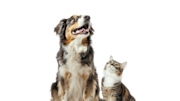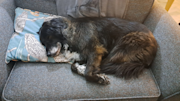
Pet insurance
5% pet insurance discount
Co-op members get a 5% discount on Co-op Pet Insurance each year. Subject to minimum yearly total costs of £51.59 for dogs and £50.68 for cats.

As dogs get older, their needs can change. I have noticed this with my 10 year old crossbreed Mabel. Mabel has slowed down a little but is still a puppy at heart.
It can be a sad accepting they are getting older, and we did have some trial and error when adapting to her new normal. I’ve pulled together some tips, so whether your dog is already in their golden years or just starting to show signs of aging, hopefully these will help.
Mabel is less active than she used to be, both in and out of the home. We noticed her weight creeping up and for Mabel and her joints, this was a bad combination. Older dogs often need fewer calories but more nutrients. We found switching her to mature or senior dog food, monitoring the amount we gave her and switching to low fat treats, allowed her lose weight and move around more comfortably.
Our vet did a free weight clinic where they talked through the best food for her and how much she would need of it. It’s always best to speak to your vet about the best diet for their breed, weight and health conditions before making any changes.
One of the most common issues in older dogs is joint stiffness or arthritis. You will probably notice them being slower to get up or less enthusiastic on walks, which happened with Mabel.
Our vet recommended a joint supplement. As a result of this Mabel has been taking YuMOVE supplements for a couple of years and I was shocked by the difference a couple of tablets a day make. Normally Mabel would be a bit stiff after long walks or in the morning after not moving for a bit, I noticed a big change once we started the supplements.
You can see the range from YuMOVE (Ad). We will earn a small commission if you buy from YuMOVE.
Your dog may not be up for long hikes anymore, but they still need daily movement. Gentle, consistent exercise helps maintain muscle mass, mental stimulation, and overall health. Shorter, more frequent walks are ideal, letting your dog set the pace.
It is lucky that Mabel’s a swimmer as this gives her a good workout, whilst also being kinder to her body. We also changed things up on our walks, focusing on mental stimulation more than physical. I used to through a ball for her to chase, now I hide a ball in the field for her to find. It has quickly become her new favourite game. Puzzle feeders, different toys and new smells to explore can also help keep their brain sharp.
Older dogs need more rest so give them a comfortable area with a warm soft bed where they won’t be disturbed by other pets or visitors.
I’m more cautious of Mabel jumping off the bed or into the car now. I’ve been researching looking at getting a ramp or stairs to help with this. I’m also considering a warm outside water tap to help make bath time a little easier for everyone.
If you have smooth, hard floors you can use rugs, runners or carpet to prevent your older dog from slipping.
Mabel also has cataracts so has lost some vision, I’ve made sure there are no sharp corners for her to bump into and after noticing she struggles to see well in the dark, I’ve installed a nightlight around the stairs for her.
Senior dogs will go through many changes as they age from being less playful to losing or gaining weight, but in some cases, these could be due to medical conditions. It’s important to take your dog to the vet if you notice any changes in their behaviour or if you feel that something isn’t right. If you are with Co-op Pet Insurance, you can speak to a vet any time with unlimited 24/7 video calls through FirstVet.
My final tip is to enjoy these senior years and all the fun that comes with it. Sometimes it can be sad when they struggle doing something they just to find so easy but I’m really enjoying the extra cuddles I get now and how calm she is in comparison to those chaotic puppy years.